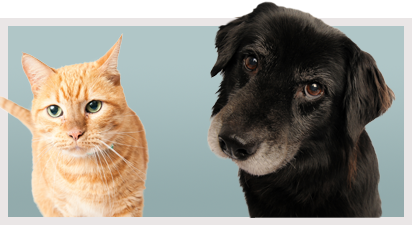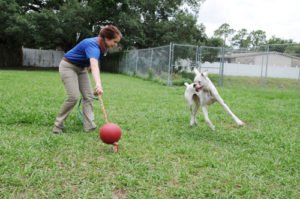Why Old Dogs and Cats Need New Tricks

Play and activity in pets may stave off cognitive decline and improve cognition in those already starting to slope downward.
As medical science extends the lifespan of pets, age-related cognitive decline in cats and dogs is on the rise. Clinical signs associated with cognitive dysfunction – often characterized by the acronym DISHAA: disorientation, social interactions, sleep-wake cycle disturbances, house soiling, activity changes (apathy or aimless wandering) and increased anxiety – are reported in almost half of dogs over the age of 10 and 30% of cats over the age of 11.
Fortunately, more veterinarians and pet owners are not accepting these as inevitable aging changes. Pharmaceuticals and nutraceutical supplements to enhance neuron functioning or reduce oxidative damage should be implemented immediately after signs are reported. But nondrug interventions such as exercise and environmental enrichment are showing exciting physical and mental benefits across species.
 In one study, older dogs receiving environmental enrichment plus an antioxidant diet showed the most improved cognitive scores, while environmental enrichment alone improved scores more than the group given the dietary treatment without enrichment. Physical activity has been shown to slow the progression of Alzheimer’s disease in people. Increased perfusion to brain tissue, decreased body weight, upregulation of growth factors and improved synaptic plasticity may all be molecular mechanisms underlying the benefits of enrichment and activity therapies.
In one study, older dogs receiving environmental enrichment plus an antioxidant diet showed the most improved cognitive scores, while environmental enrichment alone improved scores more than the group given the dietary treatment without enrichment. Physical activity has been shown to slow the progression of Alzheimer’s disease in people. Increased perfusion to brain tissue, decreased body weight, upregulation of growth factors and improved synaptic plasticity may all be molecular mechanisms underlying the benefits of enrichment and activity therapies.
Enrichment can be described as providing enhanced environmental stimuli. For our companion animals this means not just meeting their basic needs for health, nutrition and safety, but also providing low-stress and predictable social interactions, play, outlets for other natural behaviors, and sensory-stimulating opportunities. Of course, medical issues such as metabolic disease, dental disease and orthopedic pain should be addressed before starting enrichment activities in senior pets.
Some practical enrichment ideas include:
- Providing food toys or puzzles that encourage manipulating the device to receive food. Many commercial products are available and DIY ideas can be found on various websites.
- Hiding food pieces around the house to simulate searching behavior.
- Taking dogs on outdoor walks to provide some aerobic exercise and sensory exposure; in physically debilitated animals, a pet stroller or car rides can provide the sensory experience. (Note that many dog owners think placing the dog in the backyard can substitute for walks. However, outdoor time in the typical backyard does not provide the same benefits because of the lack of novelty and activity.)
- Providing safe outdoor time for cats with bungee harnesses or cat-specific fencing. Screened porches or outdoor enclosures do not encourage as much activity as walks or large fenced areas, but placement in sight of butterfly gardens or bird feeders increases the sensory stimulation.
- Ensuring there is vertical space for cats both indoors and outdoors to help foster activity and provide safe places in a multi-cat household.
- Spending a few minutes each day on reward-based basic obedience or simple trick training – a great method for mental stimulation and appropriate social interaction, especially in less mobile animals.
- Encouraging play even in older animals. A play partner should support the appropriate level activity and not pester or distress the older animal. Toys can also be a good outlet for older animals but daily rotation, food and owner facilitation may be necessary.
Evidence suggests that attention to environmental enrichment may make the most impact if started in median-aged animals.6 Ask clients about clinical signs of cognitive dysfunction and start supplements, activity and enrichment early.
Courtesy of Julia Albright, MA, DVM, DACVB | Veterinary, Medicine- Behavior (11)
- Caring for your pet (263)
- cat (4)
- Community Events (19)
- dog (6)
- From Our Clients (15)
- Happy Tails (8)
- News (418)
- Press (53)
- Products (2)
- Questions (4)
- Recalls (1)
- Special Offers (5)
- Tips & Advice (231)
- Uncategorized (19)
- Veterinary Services (48)
